Plums could be a potential crop for growers and homeowners in Florida and other mild winter areas throughout the Gulf coast, but many plum varieties from the west coast will not consistently perform well enough in Florida to produce fruit. However, the University of Florida's stone fruit breeding program has developed cultivars that improve the potential for growing plums in Florida and other mild winter areas that have high disease pressure. These cultivars are recommended for trial in Florida. The names of all University of Florida plum cultivars begin with the prefix 'Gulf.' These cultivars are Japanese type plums (Prunus salicina Lindl.) and have resistance to plum leaf scald (Xylella fastidiosa) and bacterial spot (Xanthomonas campestris). Fruit size is satisfactory (about 1½ to 2 inches in diameter) with good fruit quality. They ripen in early to late May, approximately two weeks before plums from other areas arrive in the marketplace.
Chilling Hours and Heat Units
"Chill hours or units" refers to the hours of temperature below 45°F and above 32°F that occur while the tree is dormant (Figure 1). Deciduous trees require a certain number of these units for vegetative and floral buds to break in a timely manner and begin the growing season. Fruit trees with higher chilling requirements typically grow well and produce fruit in higher chill locations, such as the northern part of Florida or northern states. If a plum adapted to a northern area is grown in Florida, it will not break buds properly and adapt to our climatic cycle. The 'Gulf' series of plum trees have been developed to adapt to our mild low-chill winters. They will produce fruit from the Fort Myers area to the panhandle of Florida, the lower southern regions of Georgia, and the warmer areas of the Gulf coast states. These plums bloom with the 150 chill unit peach cultivars at Immokalee, the 200–250 chill unit peaches in Orlando, the 250–350 chill unit cultivars at Gainesville, and with the 400–500 chill unit peaches at Quincy.
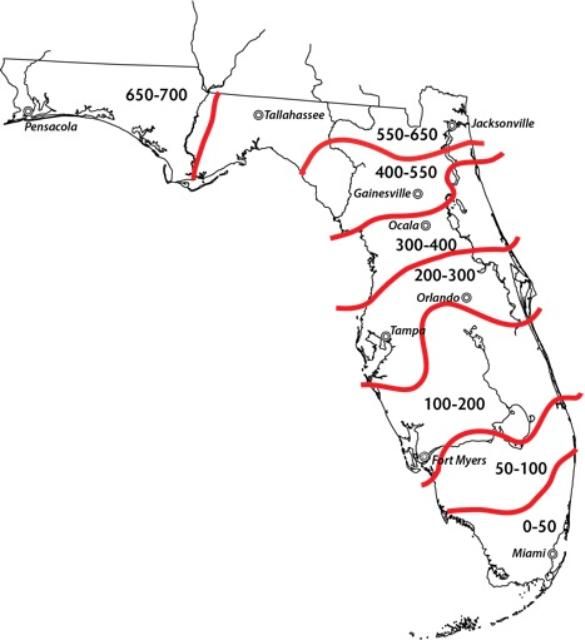
Although the 'Gulf' series plums have a low chilling requirement, they need more warm days than low-chill peaches to break winter dormancy. This condition is referred to as a heat requirement, which is a period of night temperatures above 55°F and day temperatures above 65°F. For the 'Gulf' series of plums, 1–2 weeks of these conditions are required to have uniform bud break. During most winters in Florida, the 'Gulf' series plums do not flower early enough to be overly susceptible to frost or freeze injury during late winter or early spring. Similarly, they do not show symptoms of inadequate chilling, such as delayed bloom or leafing that can lead to reduced fruit set or the absence of fruit set.
Pollination and Fruit Set
The 'Gulf' series plums, like most Japanese plums, are not self-fruitful and require cross-pollination for fruit set (Figure 2). Generally, any cultivar will be pollinated by a different cultivar as long as their bloom period overlaps and pollinating insects, such as honey bees, are active. The two species of native plums, P. angustifolia (Chickasaw plum) and P. umbellata (hog plum) or their hybrids can serve as pollinators, but they usually bloom earlier than the 'Gulf' series and their fruit quality is poor. Trees for pollination are planted in a ratio of 1 pollinator for every 5–8 cropping trees. Cropping ability in the 'Gulf' plums is very high and fruit thinning must be done in order to obtain large fruit and keep limbs from breaking. Fruiting occurs both on spurs and along the previous season's shoots. These plums are precocious, often fruiting in the second year after planting.

Credit: M. Olmstead, UF/IFAS
Fruit Development Period
The fruit development period refers to the period from fruit set during bloom to fruit harvest. It is affected by temperatures and can be shortened by long periods of above average temperatures and lengthened by long periods of below average temperatures. Typically, it is used as an indicator of when the fruit will be harvested. Bloom periods for the 'Gulf' series plums generally occur in late January in south Florida, early to mid-February in central and north-central Florida, and mid-February to early March in north and northwest Florida. 'Gulf' series plums have a fruit development period between 75 to 95 days, depending on the cultivar and seasonal growing conditions.
Fruit Harvesting and Handling
In Florida, plums are harvested by hand, from early May through early June. Fruit should be cooled as quickly as possible after harvest. There are several options for cooling including forced air systems, hydro-cooling, or cold room storage. Firm fruit can be carefully bulk packed in a box or placed in cell pack divider trays. A tree will normally ripen its fruit over a 10- to 15-day period corresponding with the length of bloom and the efficiency of pollinators. Fruit of the 'Gulf' series are firm, but if picked late, they will soften quickly. Proper harvesting time allows the fruit to ripen in transit to consumers with a shelf life of 1 to 2 weeks. Recommendation for postharvest storage from temperate climates should be applicable to Florida plum varieties (http://postharvest.ucdavis.edu/PFfruits/Plum/), although detailed studies have not been conducted for low-chill plum varieties. Optimal storage temperatures for plums is 30.5°F–32°F, with a relative humidity of 90%–95%. Air movement in a cold room or refrigerator is recommended (approximately 50 cubic feet per minute).
Yields
Plum fruit must be thinned to allow for satisfactory fruit size. Yield from a mature plum tree that has been properly thinned will be about 1 to 1½ bushels or about 40 to 50 lbs. of fruit per tree.
Plum Cultivars Adapted to North, North Central, and Northwest Florida
'Gulfbeauty' was released in 1998 and patented by the University of Florida. Its chilling requirement is about 225 hours. Fruit color is dark reddish purple, and the flesh is yellow with a green hue (Figure 3). The skin is sour, which is common in Japanese plums, but the flesh is sweet, sub-acid, and firm when ripe. The fruit is clingstone and clings to the stone even when soft ripe. Fruit are round and medium-sized (1¾ in. in diameter), and weigh from 55 to 70 grams. Bloom and cross-pollination occur with all other 'Gulf' series plums. Fruit set is good with flowers formed on spurs and the previous season's shoots. 'Gulfbeauty' is the earliest plum to ripen from the University of Florida breeding program, with a fruit developmental period of 75 days.
Ripening occurs about 5 days before 'Gulfruby' and about 8–12 days before 'Gulfblaze.' As the fruit approach full ripe, their color becomes noticeably darker (Figure 4). Ripe fruit will hang on the tree for 7–10 days. Quality is good, especially for an early ripening plum. During its season, no other fresh plums are available. Trees are vigorous with tall upright shoots and semi-spreading. In the absence of freezing conditions, thinning is required to obtain adequate size and prevent limb breakage. Trees are very resistant to bacterial canker and moderately resistant to plum leaf scald.
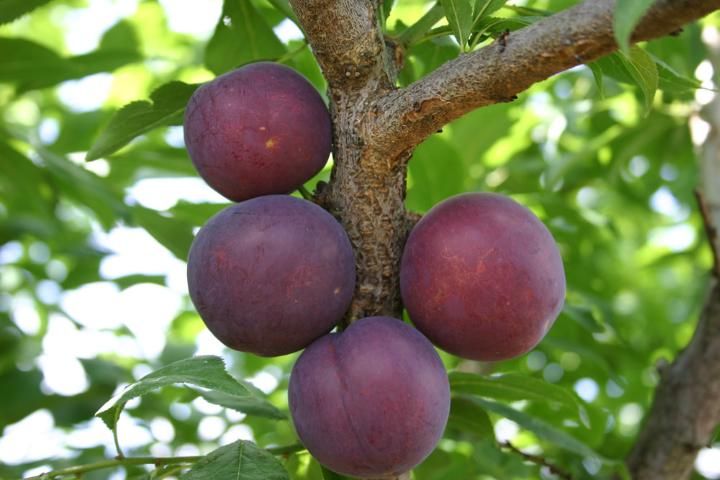
Credit: P. Miller, UF/IFAS
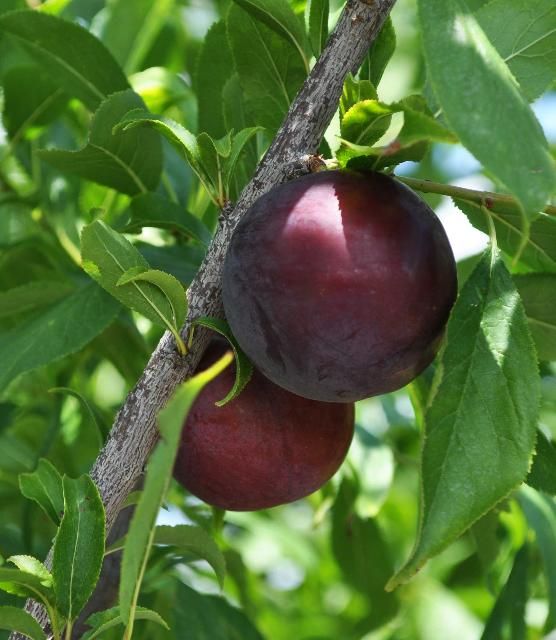
Credit: M. Olmstead, UF/IFAS
'Gulfblaze' was released and patented by the University of Florida (Figure 5). Fruit ripen in the middle of the Florida plum season. The chilling requirement for 'Gulfblaze' is about 250 hours. Bloom and cross-pollination occur with all other 'Gulf' series plums. Fruit set is good with flowers formed on spurs and the previous season's shoots. Fruit are very firm, average in size (1 7/8 to 2 in. in diameter), and weigh 70 to 80 grams. Fruit is round and semi-freestone with flesh weakly attached to the pit when ripe. Fruit color is dark red to purple and the flesh is orange, sweet, and sub-acid (Figure 6). The skin is sour, although overall fruit quality is good. Fruit ripen 8 to 14 days after 'Gulfbeauty' with a fruit developmental period of 95 days. Bloom, pollination, fruit set, and ripening characteristics are the same as for 'Gulfbeauty'. The leaves, stems, and fruit have similar resistance to bacterial canker and plum leaf scald as 'Gulfbeauty'.
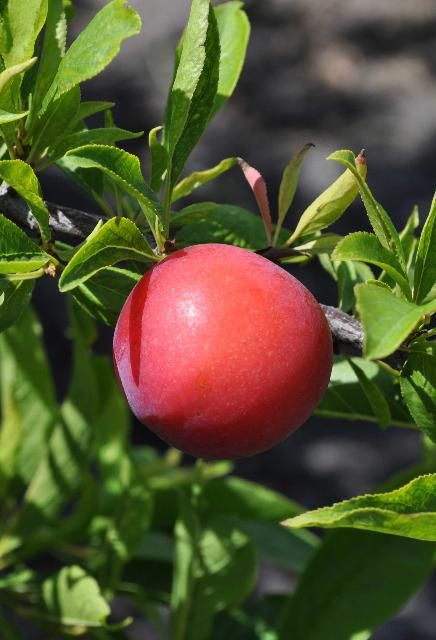
Credit: M. Olmstead, UF/IFAS
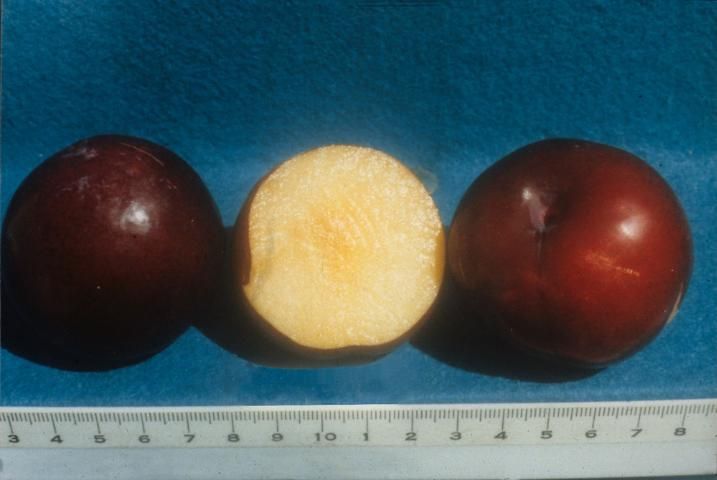
Credit: UF/IFAS
'Gulfrose' is also patented by the University of Florida and ripens about one week later than 'Gulfblaze', with a fruit developmental period of 95 days (Figure 7). The chilling requirement is about 275 hours. The fruit are nearly round, semi-freestone, average in size (1 7/8 to 2 in. in diameter), and weigh 70 to 80 grams. The skin is dark reddish purple, and the flesh is blood red in color (Figure 8). Fruit quality is high with good firmness and shelf life. The fruit have a sweet, aromatic flesh and a moderately sour skin. There is no bitter aftertaste common in other blood plums such as 'Mariposa'. Bloom, pollination, fruit set, and ripening qualities are the same as for those of 'Gulfbeauty'. Trees are moderately vigorous, semi-spreading, and precocious, bearing the second year after planting. 'Gulfrose' has similar resistance to bacterial canker as 'Gulfbeauty'; however, it is less tolerant to plum leaf scald than 'Gulfblaze' with similar susceptibility to 'Gulfgold', limiting tree longevity.
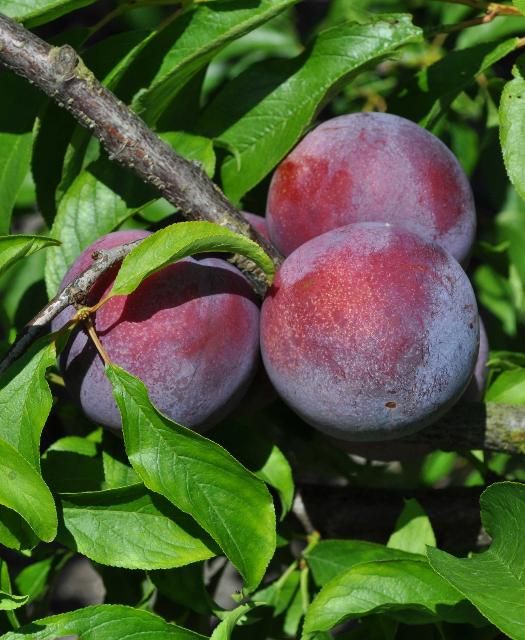
Credit: M. Olmstead, UF/IFAS

Credit: UF/IFAS
'Gulfruby' originated at the University of Florida breeding program but was not released by the university because of its susceptibility to bacterial canker. It was first propagated along with 'Gulfgold' in 1982 by Grand Island Nursery in Umatilla, Florida. It is not patented and is, therefore, a public variety. Bacterial canker readily occurs on leaves and small twigs of 'Gulfruby' and is aggravated by frequent summer rains. Generally, the tree may survive from 5 to 8 years and provide several crops of early ripening plums. Fruit are medium in size, up to 2 inches in diameter, and are round in shape (Figure 9). The flesh is sweet, yellow in color with a greenish tinge, and adheres to the small pit at soft ripe. Skin color is red to purple with sour characteristics. Fruit will hang on the tree 3–5 days after full red skin color develops and will ripen 7–10 days before 'Gulfblaze.' The tree is not as vigorous nor does it possess as much of the strong upright shooting tendencies of 'Gulfbeauty'. 'Gulfruby' has more problems with bacterial canker than the other low chill cultivars recommended for trial. It can cause cankers on the wood and significant leaf damage leading to defoliation, which can result in sunburn on the fruit due to leaf loss.
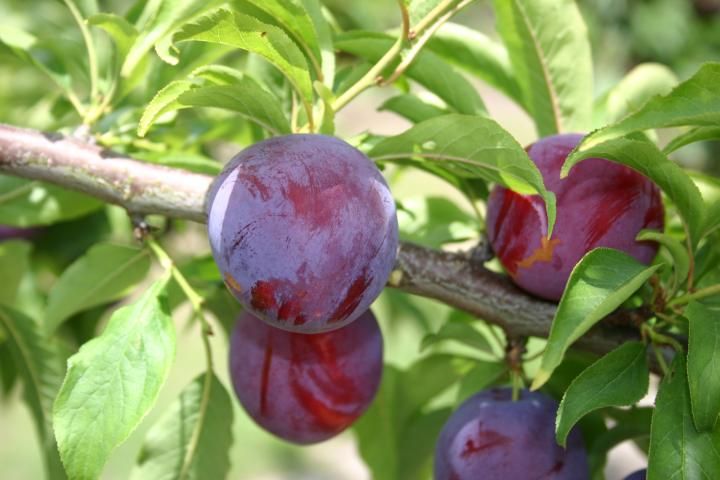
Credit: P. Miller, UF/IFAS
'Gulfgold' is a yellow skin plum, but develops a red blush as ripening progresses. Fruit flesh is yellow and semi-soft when ripe. Although developed by the University of Florida, it was not patented. Fruit ripen in late May to mid-June. They are the sweetest of the 'Gulf' series. 'Gulfgold' is susceptible to plum leaf scald, which generally limits tree life in Florida. Trees are dwarfing in growth habit. Bloom is after 'Gulfruby' by a few days, and 'Gulfgold' will cross-pollinate with the other 'Gulf' plums.
Plum Cultivars Conditionally Recommended for Trial for North Florida Due to a Higher Chilling Requirement
Plum cultivars with the Au prefix have been released from the University of Auburn plum breeding program and 'Robusto', 'Segundo', and 'Byrongold' are from the USDA-ARS stone fruit breeding program in Byron, GA. They can cross-pollinate each other. Florida nurseries may sell other varieties such as 'Scarlet Beauty'; however, there is no data available on their tree or fruit production characteristics.
'Au-Homeside' produces a light red plum with amber flesh. Fruit size is oval and about 2 1/3 inches in diameter. Fruit is attractive and overall quality is good. Fruit ripens in mid-June, and fruit tends to size well before color is achieved. Trees are not vigorous, but 'Au-Homeside' is tolerant to plum leaf scald.
'Au-Producer' has dark red skin and the flesh is also red. Fruit size is small, round, and less than 2 inches in diameter. Fruit quality is high and the fruit ripens in mid-June. Tree vigor is moderate, but trees require heavy thinning. 'Au-Producer' is tolerant to plum leaf scald. Chilling requirement is about 750 units.
'Au-Roadside' produces a magenta fruit with a red flesh color. Fruit size is less than 2 inches in diameter and is oval in shape. Fruit quality is very good and fruit ripens in mid-June. Trees are highly vigorous. Fruit tends to be too soft for commercial shipping. 'Au-Roadside' is tolerant to plum leaf scald. Chilling requirement is about 750 units.
'Au-Rosa' produces red fruit with some light yellow areas. Fruit size is 2 inches in diameter and round in shape. Fruit quality is good and fruit are attractive. Fruit ripen in mid-June. 'Au-Rosa' is resistant to plum leaf scald. Chilling requirement is about 750 units.
'Au-Rubrum' skin color is maroon and flesh color is red. Fruit size is 2 inches in diameter and round in shape. Ripening date is mid-June. Tree vigor is good. 'Au-Rubrum' is tolerant to plum leaf scald. Chilling requirement is about 750 units.
'Byrongold' produces a fruit with yellow skin and flesh. Fruit develop red blush during the latter part of ripening. Fruit are round and approximately 2 inches in diameter. Fruit ripen in late June to early July with good firmness and fruit quality. Trees are highly vigorous, but may have some problems with leaf scald. Chilling requirement is about 450 units.
'Excelsior' is a native plum discovered by George Tabor of Glen St. Mary's Nursery and requires approximately 400 chilling units. Both the flesh and fruit are yellow. The fruit size is about 2 inches. The flesh is somewhat translucent and watery.
'Methley' is an older variety that is no longer recommended because of small fruit size, lack of firmness, and susceptibility to plum leaf scald and other diseases of bacterial origin. It is self-pollinating. Chilling requirement is about 650 units.
'Robusto' produces a red fruit with yellow flesh and ripens in early June. The tree blooms in early March and requires approximately 400 to 500 chill units.
'Santa Rosa' produces a purple/red colored fruit with red flesh. Santa Rosa is an older cultivar that is no longer recommended because of susceptibility to plum leaf scald and other diseases of bacterial origin. Chilling requirement is about 650 units.
'Segundo' is a red plum with yellow flesh that ripens in mid- to late-June. The fruit are somewhat soft, and the tree requires approximately 400 to 500 chilling units.
Orchard Establishment
Plums, like all fruit trees, should be planted in full sun. The best soil and location for plum culture is a well-drained sandy loam located on hilltops with good air drainage for spring freeze protection. If the site has poor drainage, adjustments must be made to improve drainage before orchard establishment, as plum trees do not tolerate extended periods of flooding. 'Flordaguard' or 'Nemaguard' peach rootstocks or plum / plum-hybrid rootstocks such as 'Sharpe' should be used to reduce the impact of nematodes, particularly peach root-knot nematode (Meloidogyne floridensis), which is found only in Florida. The use of nematode-resistant rootstocks is most critical in sandy soils. Fertile soils high in organic matter are preferred over non-fertile soils for reducing nematode populations.
Orchard establishment for plums is similar to that of peaches and nectarines. Plums should be planted with either 12 x 18 ft. or 15 x 20 ft. within and between rows, resulting in 201 to 145 trees per acre, respectively. Tighter spacing of 12 ft. between rows can be used but can be difficult to maintain once trees have reached full size.
A soil test should be taken both before establishment to make adjustments and annually. Plums grow well when the soil pH is in a range of 5.5 to 6.5. Soil test results will provide recommendations for the addition of lime or sulfur based on the target pH. It is most efficient to apply lime or sulfur to soil after weeds or grasses have been removed from around the tree.
During late summer or early fall before orchard establishment, weeds in the planting row can be removed manually or by using herbicides. If applying herbicides, do not till the ground until after weeds have been killed. Tilling the in-row strips will also facilitate tree planting, early weed control, and early tree growth. For more information see https://edis.ifas.ufl.edu/wg023.
Plant bare-root trees in December or January at the same depth they were grown at in the nursery. All roots should be covered by soil. Containerized trees can be planted any time during the year, but if roots have been pot-bound, they are best planted when dormant to facilitate root development before leafing. Water trees thoroughly at planting.
During the first year after establishment, the four main considerations are irrigation, weed control, fertilization, and rabbit or deer damage. In most locations, irrigation is essential. Weed control is critical, either by manual methods or by the use of pre-emergence and post-emergence herbicides. For homeowner plantings, manual methods of weed control may be satisfactory, while herbicides may be the method of choice for medium to large plantings. If herbicides are the method of choice, they may have to be applied throughout the year. Initially, a weed-free, in-row strip about 3 ft. wide is satisfactory. It should be expanded to 5 ft. after a few years as trees grow larger.
Training, Pruning, and Fruit Thinning
Training refers to the process of shaping the basic tree framework, while pruning refers to the removal of shoots and limbs to promote continued tree productivity (https://edis.ifas.ufl.edu/hs365). When planting a bare-root tree, training begins the first year by removing at least 1/3 of the top ("heading back") to balance shoot growth with growth of the root system. Ideally, trees should be 2½ to 3 ft. tall after heading back. Most of the buds will break within 1 ft. from the top. Remove all buds below 18 inches in height. Generally, 3 to 5 bud-shoots are equally spaced around the trunk to form the scaffold limbs. Shoots should be encouraged to grow at a wide angle (>45°) from the trunk to form a strong framework. Scaffold limbs and vigorous shoots may be trimmed back or removed if the center of the tree gets crowded. During the second and subsequent years, secondary limbs will develop from the primary 4 to 6 scaffold limbs.
Vigorous shoot growth each year requires annual pruning. Most of the pruning is done during dormancy (December to February). For the first few years, more new growth can be retained than in later years when trees approach their desired size. Pruning controls tree height, eliminates branches that cross or tangle, and allows adequate light to penetrate the interior. Plums can be trained with either a central leader system, as with apple, or with multiple leaders that are spread to limit tree height. Mature trees are topped, limiting their height to around 8 ft., so fruit can be picked without the use of ladders. Summer pruning in June after fruit harvest follows the same objectives, but less wood is removed, and thinning out tree interiors is a focus of this pruning time. Many plum cultivars set fruit on long shoots ("whips"). These whips are cut back to 1–3 ft. to limit fruit load and prevent limb breakage. In addition to forming fruit on whips, older trees set fruit on 2–4 ft. spurs, so some of these can be removed to limit crop load (Figures 10 and 11). Pruning should be used to reduce the amount of hand fruit thinning that would be necessary. Delaying pruning in the late winter and early spring during the frost period delays bloom and can help to ensure that a sufficient crop load is set.
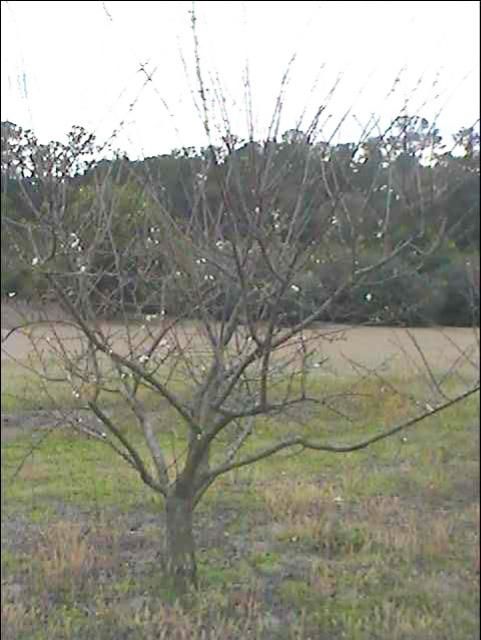
Credit: P. Miller, UF/IFAS
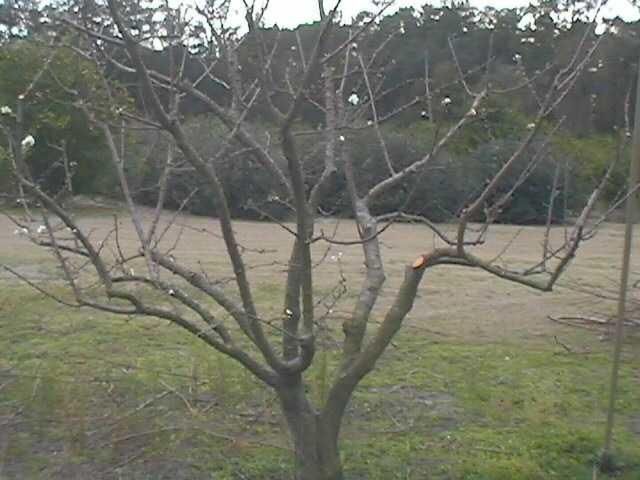
Credit: P. Miller, UF/IFAS
One of the most significant activities in stone fruit production is thinning the crop load to develop marketable fruit size. Fruit are removed by hand, about a month after bloom when fruit are ¼ to ½ in. in diameter. Effective thinning to improve fruit size must be done before pit hardening, otherwise thinning efforts do not increase fruit size. Fruit may be subject to "late drop", sometimes called "June drop" in northern climates, which results in fruit aborting from the tree. This occurs due to incomplete pollination, and thus no seed forms.
Ideally, fruit should be spaced 3 to 6 in. apart. If the crop is light, only heavy clusters should be broken up. Since plums have a long bloom period and multiple waves of fruit set, thinning must be done multiple times. Thinning should not be initiated until the danger of freezing temperatures in late winter/early spring has passed.
Freeze Protection
During winter dormancy, prior to bud swell, freeze damage seldom occurs to plum trees in Florida because minimum temperatures must drop below 5°F for injury to occur. However, crop damage can occur in late winter when flowers are exposed to sub-freezing temperatures (<32°F). The most likely scenario for this damage is after the passage of a cold front, with either an advective or radiation freeze event. An advective freeze occurs with cold, windy conditions, while a clear, calm night sky allows the radiation of heat from the earth's surface to the atmosphere inducing a radiation freeze. The critical minimum temperature that a flower bud can tolerate is dependent on the stage of its development. During bud swell, flower buds can tolerate 25°F without damage. However, after flowers have opened and/or the fruit have formed they can only tolerate 28°F–30°F. Even at these temperatures damage can occur depending on the duration of exposure.
For protection from freezing temperatures, trees can be covered with a tarp or other material. However, covers alone do not adequately protect fruit buds from damage, so a heat source must be used. Water from microjets used for irrigation will provide an excellent source of heat. This trapped heat and fog will provide protection from very low temperatures. Electric heat sources such as light bulbs placed underneath the tarp can also be used.
Another method of cold protection is overhead irrigation (Figure 12). When water freezes, it releases heat to the object that it is in contact with as it transitions from a liquid to a solid phase. During many Florida freezes, sufficient water can be applied through overhead irrigation systems to protect flowers and young fruit from freeze injury. Significant protection will only be realized if flower buds are contacted with water spray continuously. Water must be continuously applied until the ice has melted the following day or the wet bulb temperature is over 32°F. Limb breakage may occur as a result of the weight of the ice.
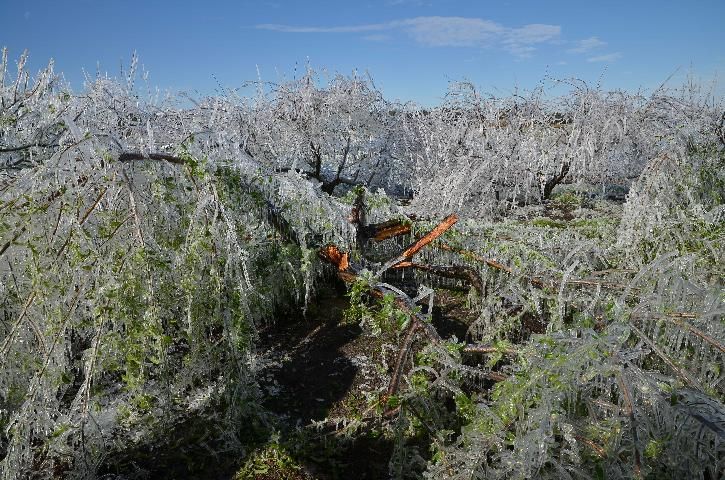
Credit: M. Olmstead, UF/IFAS
The rate of water application and coverage are critical for freeze protection. Some factors that affect the rate of water application include temperature, relative humidity, and wind speed. Generally, water volume must be at least 1/3 in. per hour for wind velocities less than 10 mph. If insufficient water is applied, or sprinklers do not provide adequate coverage, then the amount of freeze damage may be greater than if no water had been applied at all. Disadvantages of freeze control with irrigation include the breakage of scaffold limbs (Figure 12) and shoots with the weight of ice, the use of a large amount of water applied to the area, and the investment in large wells with diesel power, which is more reliable than electric power. A more thorough discussion of freeze protection can be found in Protecting Blueberries from Freezes in Florida at https://edis.ifas.ufl.edu/HS216.
Irrigation
Irrigation is necessary during orchard establishment and is important to provide moisture during dry periods of the growing season. Drip, microjet, or overhead irrigation can be used, each of these having advantages and disadvantages. Drip irrigation uses the least amount of water and does not wet the foliage. In clay soils of north Florida and the panhandle, water from a drip emitter will spread laterally to cover the root zone. However, in sandy soils, a single drip line down the row will not wet the entire root zone because of vertical water movement. Microjets are similar to drip irrigation, but provide better coverage of the root zone. Both of the low volume methods require maintenance to eliminate particles and/or precipitates that clog the orifices. Overhead irrigation will permit watering between row cover crops, and it is easier to spot clogged nozzles with this system. It also serves as a freeze protection system.
For homeowner plantings, manual watering is satisfactory. Irrigation twice a week with 2 gallons for a small tree and up to 8 gallons for a large tree is generally satisfactory.
Fertilization
Do not apply synthetic fertilizer at planting time, unless lime is needed to increase soil pH or sulfur is needed to decrease the soil pH based on initial soil test results. Fertilization should be light during the first year. Generally, multiple applications will reduce the leaching potential.
In Florida, phosphorus is typically available in sufficient amounts in the soil and is not needed in as large amounts as nitrogen or potassium. Reducing phosphorus applications can help to reduce leaching and minimize environmental impact of excess applications. Spread from ½ to 1 lb of 10-2-10 (N-P2O5-K2O) evenly in an area about 2 to 5 ft. around each tree. Micronutrients can be supplied by using a 10-2-10 with micronutrients.
Plum trees should be fertilized every 6 weeks from March 1 through August 31 with 4 oz. of 10-10-10 per application for the first year. In the second year, the amount can be increased to 8 oz. per application. In years three and beyond, the amount per application can be increased to 1 lb. for each application.
Depending upon leaf and soil fertility levels, ammonium nitrate or calcium nitrate can be substituted for a 10-10-10. However, the amount of actual nitrogen should stay about the same. For example, 10-10-10 is 10% nitrogen and ammonium nitrate is 35% nitrogen. Thus, it takes about 3 units of 10-10-10 to equal one unit of ammonium nitrate. The choice of 10-10-10, with micronutrients or any other fertilizer or fertilizer combination, can be based on leaf nutrient levels. Optimum leaf nutrient levels are presented in Table 1. Levels of leaf nutrients below the optimum range are deficient and levels above the optimum range are excessive.
Organic and Low-Spray Production in Florida
Organic production in Florida has not been widely practiced so there is little information about it. There are very few organic plum commercial operations in the United States because of diseases and insects that are difficult to control with organic options. However a guide to organic and low-spray plum production can be found on the A National Sustainable Agriculture Assistance Program (AT-TRA) website: https://attra.ncat.org/attrapub/summaries/summary.php?pub=442.
Insects
The insects that are of major concern to plum growers are plum curculio, stinkbugs, San Jose scale or white peach scale, mites, and both peach tree and lesser peach tree borers. The insect biology, timing, and method of application, are important to prevent fruit damage.
Plum curculio is a weevil that emerges from the ground during the early part of fruit development (Figure 13). Generally, plum curculio has the potential to eliminate the entire crop of plums. The female will make a cut on the small plum fruit and deposit an egg in the flesh. The cut is crescent-shaped and heals over, forming a light brownish scar within 12 hours (Figure 14). The egg rapidly hatches and the small, whitish worm eats it way toward the pit of the fruit. If the pit or stone has not hardened but is still soft, the worm will enter the gelatinous material of the seed's embryo and feed (Figure15). The small plum will then turn reddish and drop from the tree. If the worm did not reach the seed before pit hardening, it will tunnel around the pit and then emerge. The tunnel will hold brown fras and the injury will increase chances of the fruit ripening prematurely and rotting. When the worm exits the fruit, it will pupate in the ground and emerge as an adult in as soon as 60 days and continue the cycle. Worms of succeeding generations can continue the cycle in harvested fruit rendering it unsaleable (Figure 16).

Credit: P. Miller, UF/IFAS

Credit: P. Miller, UF/IFAS
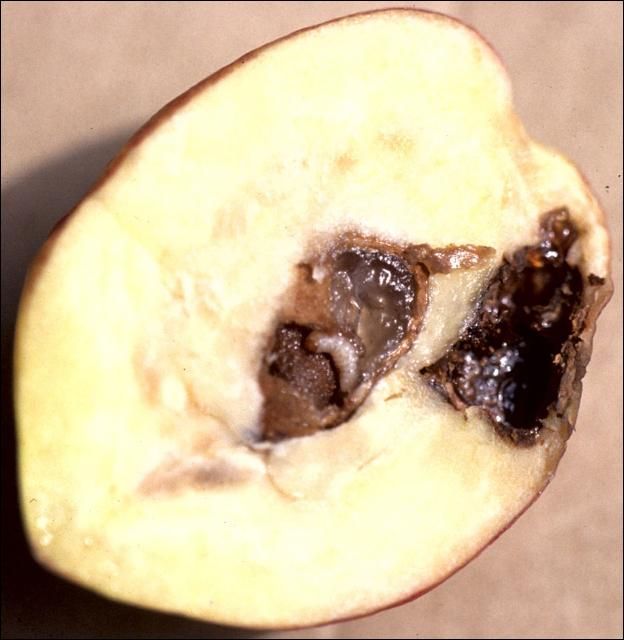
Credit: P. Miller, UF/IFAS

Credit: P. Miller, UF/IFAS
Insecticidal sprays should be applied when adults emerge from the ground. Spray recommendations can be found in Insect Management in Peaches at https://edis.ifas.ufl.edu/pdffiles/IG/IG07500.pdf or the Southeastern Peach, Nectarine and Plum Pest Management and Culture Guide (https://secure.caes.uga.edu/extension/publications/files/pdf/B%201171_10.PDF). Monitoring populations can be done with Tedder's traps placed in the orchard. Natural events, such as shuck split, when the sepals and petals are pushed off by the growing fruit, can also be used to indicate that females are present and are beginning to lay eggs. In wild plums, populations of plum curculio are present and follow a natural cycle. Shuck split generally coincides with the emergence of the curculio, so observing the wild plums for the start of this event, can help time insecticide applications.
If portions along the plum leaf edges or areas on the small fruit have been eaten by the curculio, this can be another indicator of adult plum curculio emergence. The insects usually start feeding a few days before they lay eggs. Generally, the female will start cutting fruit toward the outside of the canopy and cut each successive fruit moving down the limb toward the interior of the tree. Often, her first attempts at laying will not form a larva inside the fruit, and the crop can be adequately protected with an insecticide at the first sign of cutting. It is possible to see the curculio weevils in the tree. They are about 4mm in length and have a long snout. Moderate winds will blow them out of the tree so they are easier to spot in the morning or evening. They are not easy to find and will move around to avoid being seen. A good method to observe the insect is to place a white sheet under the tree and shake the branches. The weevils will fall and can be spotted on the white background.
Control methods and current recommendations can be obtained from your County Extension Office or the Southeastern Peach, Nectarine and Plum Pest Management and Culture Guide (https://secure.caes.uga.edu/extension/publications/files/pdf/B%201171_10.PDF).
San Jose scale is a piercing and sucking insect on the bark of trees that can be devastating if populations establish a colony. After hatching, the female probes through the bark and sucks water and carbohydrates from the tree. Approximately one week after attachment to the bark, a waxy coating develops, and the scale become difficult to kill with insecticides. The hatch does not occur all at once, which further limits the insecticide effectiveness.
San Jose scale appears as grayish, raised waxy spots on the tree bark. Unlike the larger white peach scale that can be easily spotted in the late summer because of its snowy white male populations, San Jose scale is not easy to see. However, populations can be confirmed by slicing a small sliver of bark off at the cambial layer and observing purplish dots on the limb where the female has been feeding (Figure 17).

Credit: M. Olmstead, UF/IFAS
The most effective method of control is to apply one or two applications of 0.75–1.5% horticultural oil when the trees are dormant (Horton et al. 2015). Oil will kill males, attached females, and those that are crawling before they adhere to the tree. It is critical to spray trees every year, even when first established. The best method of spraying is to use a hand gun at 300–500 psi and thoroughly soak all areas of the tree. The spray should penetrate into crevices of the bark and be applied to runoff. Air blast sprayers are often used in large orchards, but it is important to have windless conditions, slow ground speeds (125–150 gal/ acre), large nozzles, and good spray patterns. Oil applications should not be made if the night temperatures will fall below 28°F during the succeeding 4-day period. Similarly, oil should not be applied if day temperatures will exceed 85°F. Oil spreads and applies easiest when temperatures are above 60°F. Apply oil when rainfall is unlikely for the next 24 hours.
Spraying should be done after winter pruning since cover-age will be more effective. Heavy infestations require two oil applications. Multiple layers of scale will have insects on top of each other, thus the first spray will only kill the top layer. In this case the first application is applied in November or December before the January-February spray, or two weeks after the one in January. If spraying is done in the late fall, trees should be pruned early. Spray recommendations can be found in Insect Management in Peaches at https://edis.ifas.ufl.edu/pdffiles/IG/IG07500.pdf or the Southeastern Peach, Nectarine, and Plum Pest Management and Culture Guide (https://secure.caes.uga.edu/extension/publications/files/pdf/B%201171_10.PDF).
White peach scale (Pseudaulacaspis pentagona) has a broad host range, including plum. It can be found on trunks and limbs of peach, nectarines, and sometimes plum. White peach scale can be easily spotted in the late summer and fall by snowy white male populations located near the female colonies (Figure 18). At this time, populations are increasing and the trees are losing foliage making spotting easier. The females appear as white raised spots, 1/16 to 1/8 inches in diameter, with a dark center dot. This insect can be debilitating to plums. The best control is the use of dormant spray oil during the winter months, as discussed in the San Jose scale section.
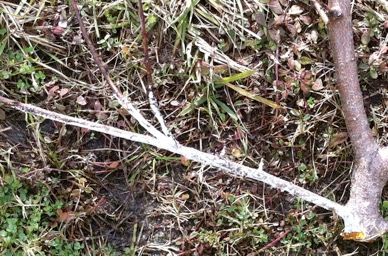
Credit: M. Olmstead, UF/IFAS
Tree borers. The peach tree borer (S. exitiosa) and lesser peach tree borer (Synanthedon pictipes) are potential pests of plums. Gummosis with fras, or sawdust within a gum mass, is an indicator of the presence of borers. They can be exposed by digging under the bark behind the gum mass in the tunnels where the white, caterpillar-like worm will be feeding (Figure 19). When they are found, borers can be killed by hand. In commercial plantings, insecticides may be applied to the trunk and other areas where borers are feeding (Horton et al. 2015). Typically, in Florida, the peach tree borer is more common and is found in the trunk near ground level. Borers prefer peach to plum wood, and since most plums are grafted to peach rootstock, borers are often in the peach rootstock before the graft union and below scaffolds. For more information on borers, see the publication Peachtree Borers in the Home and Commercial Peach Orchard at https://edis.ifas.ufl.edu/IN489. Spray recommendations can be found in Insect Management in Peaches at https://edis.ifas.ufl.edu/pdffiles/IG/IG07500.pdf or the Southeastern Peach, Nectarine and Plum Pest Management and Culture Guide (https://secure.caes.uga.edu/extension/publications/files/pdf/B%201171_10.PDF).

Credit: P. Miller, UF/IFAS
Two-spotted spider mite (Tetranychus urticae) and European red mite (Panonyochus ulmi) can sometimes build up in plum trees during dry weather from April to June. They are less than 1/16 inches in diameter and orange to red in color. Natural enemies (including an imported ladybug species, Harmonia acyridis) can often keep mites under control. Pesticides for control should not be considered unless populations build up to over 10 mites per leaf. Spray recommendations can be found in Insect Management in Peaches at https://edis.ifas.ufl.edu/pdffiles/IG/IG07500.pdf or the Southeastern Peach, Nectarine and Plum Pest Management and Culture Guide (https://secure.caes.uga.edu/extension/publications/files/pdf/B%201171_10.PDF ).
Stinkbugs and other catfacing insects (including many species of tarnished plant bugs, stink bugs, and leaf-footed bugs) can cause considerable damage to developing fruit. These are medium large (3/8 to 3/4 in. long) sucking insects that cause fruit deformities and reduce fruit market-ability. Catfacing insects can be especially damaging to fruit during the 14 days prior to harvest because their probing can lead to brown rot infections. Controlling the succulent weeds that these insects feed on will also help reduce populations. However, it is not uncommon to see many of these insects from a second or third generation appear near fruit harvest. Several properly timed sprays when large quantities of these insects are feeding in the trees will do much to aid in their control. Traps or biological control measures may be considered. More information can be found in the paper Monitoring Stink Bugs with the Florida Stink Bug Trap at http://ufinsect.ifas.ufl.edu/stink_bugs/ stink_bugs.htm. Spray recommendations can be found in Insect Management in Peaches at https://edis.ifas.ufl.edu/ IG078 or the Southeastern Peach, Nectarine and Plum Pest Management and Culture Guide (https://secure.caes.uga.edu/extension/publications/files/pdf/B%201171_10.PDF).
Western flower thrips (Frankliniella occidentalis) is a minute, barely visible insect that can cause blemishes to nectarines and plum fruit. Homeowner control is rarely warranted, but commercial control is sometimes necessary to produce fruit that is free of blemishing. Spray recommendations can be found in Insect Management in Peaches at https://edis.ifas.ufl.edu/pdffiles/IG/IG07500.pdf or the Southeastern Peach, Nectarine and Plum Pest Management and Culture Guide (https://secure.caes.uga.edu/extension/publications/files/pdf/B%201171_10.PDF).
Diseases
Bacterial spot, caused by Xanthomonas campestris pv. pruni, primarily attacks leaves but also infects shoots and fruit. Leaf infection begins with water soaked spots that change from yellow green to purple to dark brown and then eventually fall out and form a hole. On fruit, lesions and gummosis occur. Twig cankers also may cause a knobby appearance and may persist several years until twig death. The best control is to use bacterial spot-resistant cultivars such as the 'Gulf' series of plum released by the University of Florida.
Fungal gummosis is caused by Botyrosphaeria spp. and is a fungal disease that causes gummosis on the trunk and major limbs (Figure 20). This disease can be minimized by maintaining good sanitation. Remove all fruit at harvest and remove all pruning wood from the orchard environment because this organism can sporulate from decaying plant tissue. For more information on fungal gummosis in peach, see Fungal Gummosis in Peach at https://edis.ifas.ufl.edu/pdffiles/HS/HS126500.pdf.
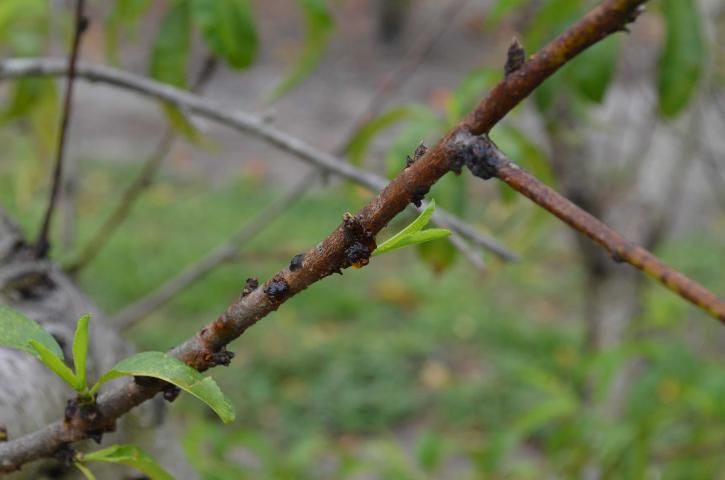
Credit: M. Olmstead, UF/IFAS
Brown rot is caused by the fungus Monilina fructicola. Brown rot can attack blooms, fruit, leaves, and stems. It over-winters on blighted stems and mummified fruit. Brown rot can be a problem during wet weather, but disease pressure is less severe than it is on peach. Infections will appear as masses of brown to brown gray spores on infected tissue. Practices designed to increase airflow throughout the tree canopy and to remove previous year's infected tissue will reduce the incidence of brown rot. There are no plum cultivars resistant to brown rot, and fungicide sprays may be necessary during wet weather.
Oak root rot is caused by the fungus Armillaria mellea and/ or A. tabescans. The disease is especially problematic in locations that harbor the remnants of oak, hickory, or forest tree roots. Thus, it is best to plant on land that has been cleared of trees for at least 20 years. Root death of plum trees is often accompanied by mushroom bodies that may be visible under the tree canopy. There is no good source of chemical control, but tolerant rootstocks are available.
Plum leaf scald is caused by the bacterium, Xylella fastidi-osa, and the disease is vectored by leafhoppers. Before planting, remove wild plum trees within several hundred yards of a potential orchard. The first symptoms are yellowing around the leaf margins and browning and desiccating of the leaf tips. This is followed by shoot dieback and tree death. The best solution is to use plum leaf scald-resistant cultivars such as the 'Gulf' series of plum released by the University of Florida.
Rabbits and Deer
Rabbits and deer can be serious impediments to the establishment of plums. Both animals will eat the bark, especially in the spring, and deer will break limbs. At planting time, various forms of rabbit guard or aluminum foil can be used to thwart rabbit damage, while a deer fence may be required where deer pressure is high. In rural areas or in areas where deer populations exist, it may not be possible to grow plum trees without protection from this animal.
References
Blaauw, B., Brannen, P., Bellinger, B., Lockwood, D., and Ritchie, D. 2018. Southeastern Peach, Nectarine and PlumPest Management and Culture Guide. https://secure.caes.uga.edu/extension/publications/files/pdf/B%201171_10.PDF
Jones, J.B, B. Wolf, and H.A. Mills. 1991. Plant Analysis Handbook, a practical sampling, preparation, analysis, and interpretation guide. Micro-Macro Publishing, Inc. ISBN1-878148-001.
Mizell, R. 2015. Insect management in peaches. ENY-801. Gainesville: University of Florida Institute of Food and Agricultural Sciences. https://edis.ifas.ufl.edu/pdffiles/IG/IG07500.pdf